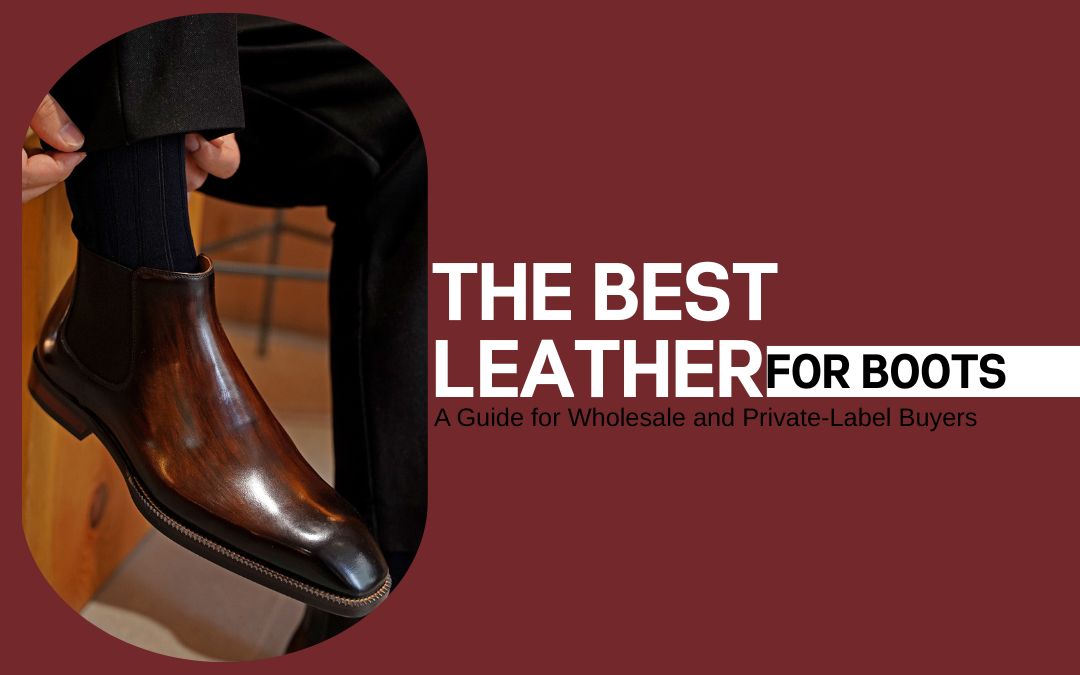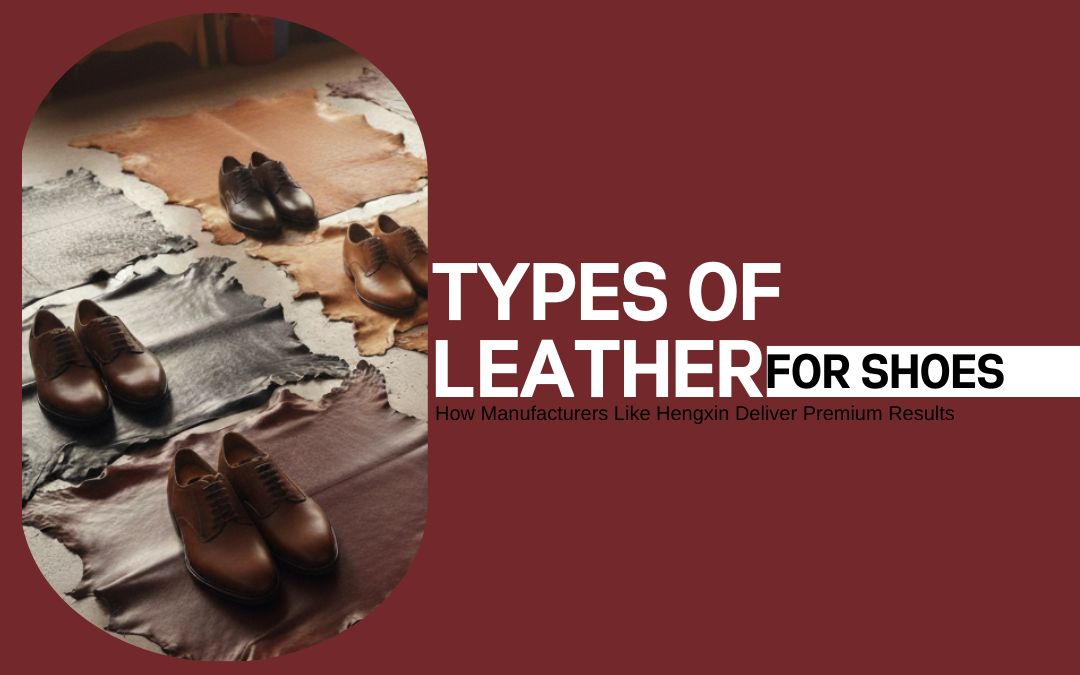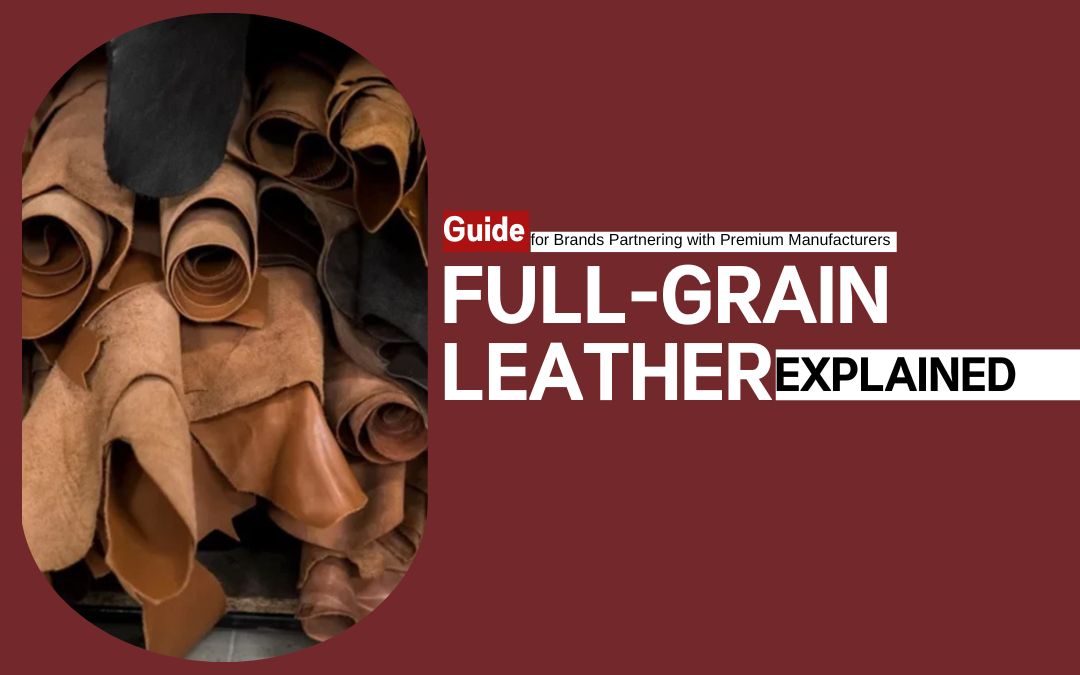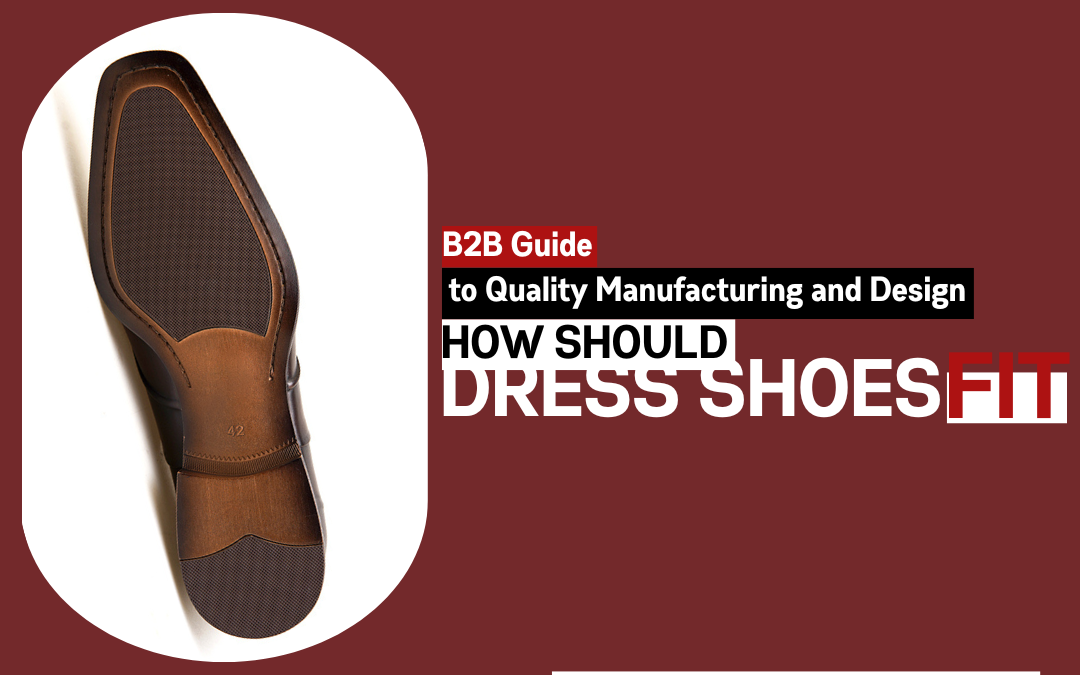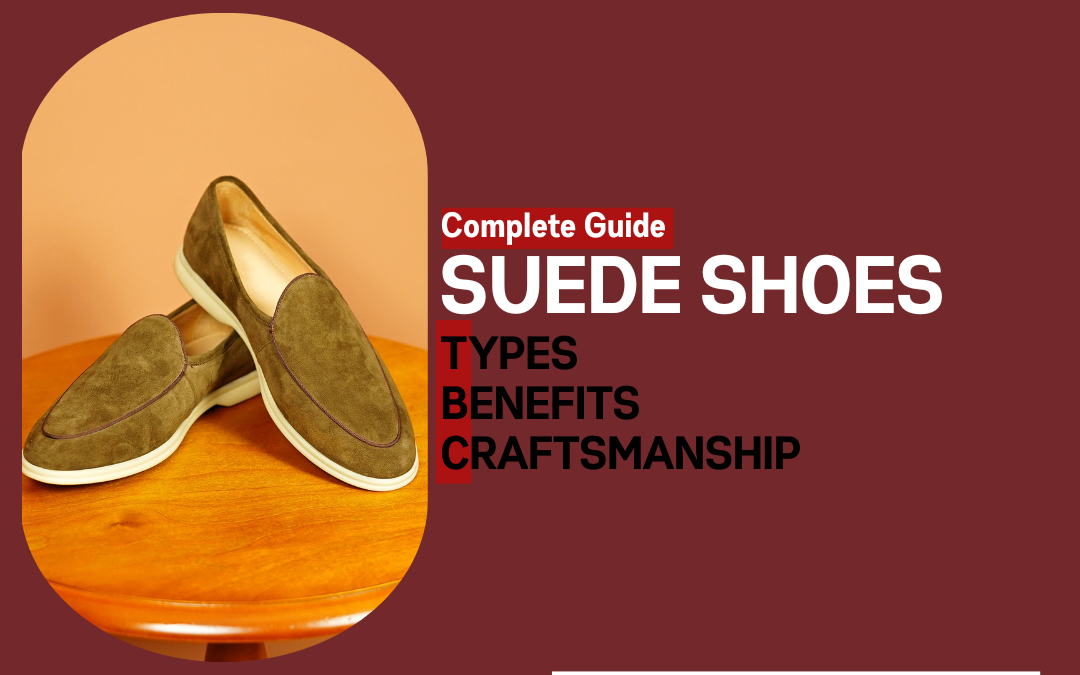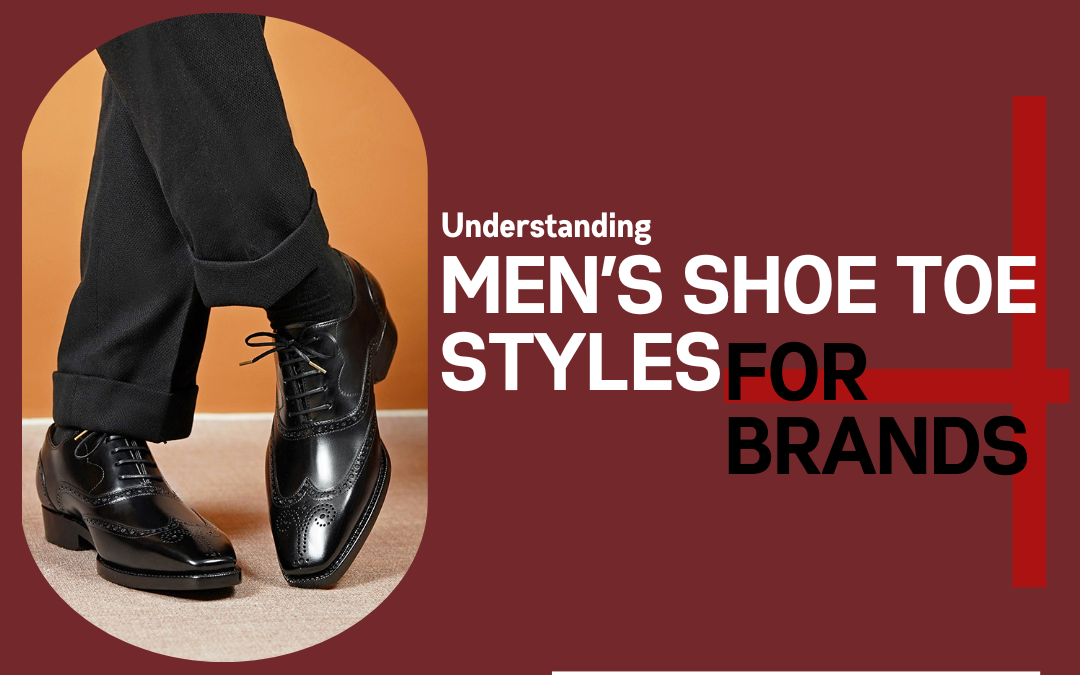When it comes to men’s dress boots, leather quality is one of the most important factors to consider.
A great pair of boots does much more than complete a sharp outfit, it also provides long-lasting comfort and durability for everyday wear.
For wholesale buyers and private-label brands in the men’s footwear market, choosing the right leather is essential.
High-quality leather not only improves the look and feel of your boots but also increases their value in the eyes of your customers.
Boots made from the best leather are more resistant to wear and tear, fit better over time, and offer greater overall satisfaction.
By focusing on top-notch materials, you show your commitment to quality and help your brand stand out from the competition.
Types of Leather Used in Bootmaking
Selecting the best leather is one of the most important steps when making or buying men’s dress boots. Each type of leather has its own look, feel, and benefits. Here is an easy-to-follow breakdown:
A. Full-Grain Leather
Full-grain leather is made from the very top layer of the animal’s hide. It keeps the original grain and surface, including tiny marks or patterns that formed on the animal’s skin. This leather is not sanded or changed much during processing.
- Why is it good?
Full-grain leather is the strongest and lasts the longest because it uses the whole thickness of the hide. It can handle daily wear and tear, making it great for boots that you want to keep for a long time.
- How does it look over time?
As you wear the boots, the leather will develop a patina. This means it gains a richer color and a unique shine, which many people find attractive. This is a sign of real, high-quality leather.
- Who should choose it?
If you want boots that are both stylish and hard-wearing, or if you want to show off a premium product, full-grain leather is the top choice.
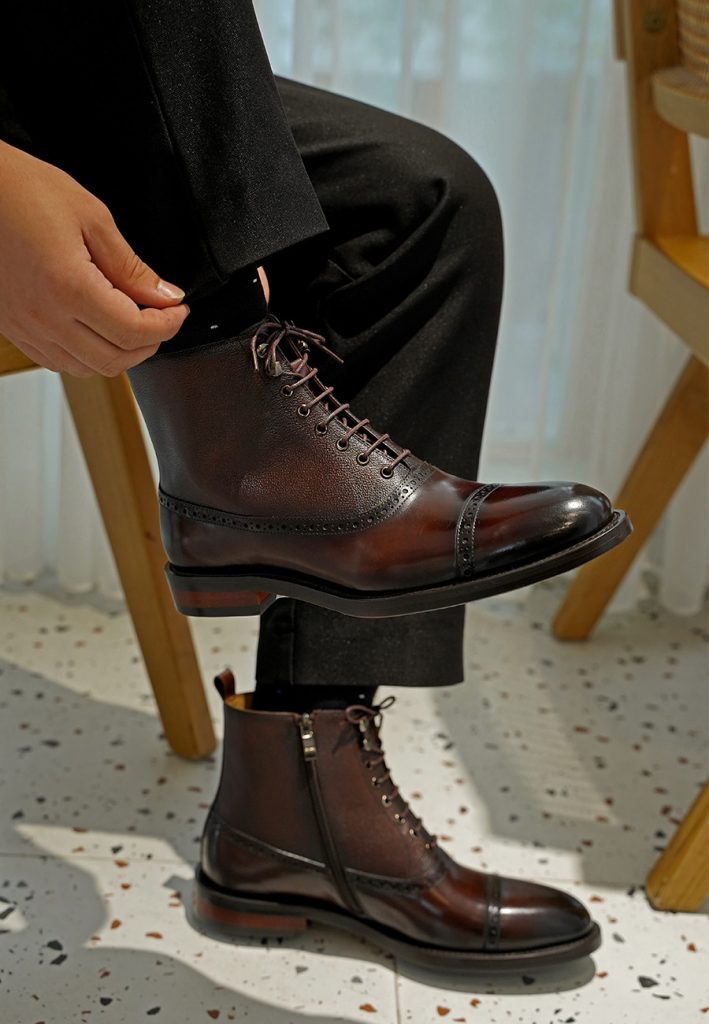
Example:
Think of full-grain leather like a solid wooden table—it may have some natural marks, but it is strong, lasts for years, and gets better as it ages.
B. Top-Grain Leather
Top-grain leather also comes from the upper layer of the hide, but it is sanded and finished to remove any natural imperfections like scars or scratches. This gives it a smoother surface.
Top-grain leather looks very neat and has a uniform color and texture. It is easier to clean and polish, making it a good option for men who want dress boots that always look sharp with minimal effort.
Top-gran leather is durable, but just a little less tough than full-grain leather. The sanding process removes some of the strongest fibers.
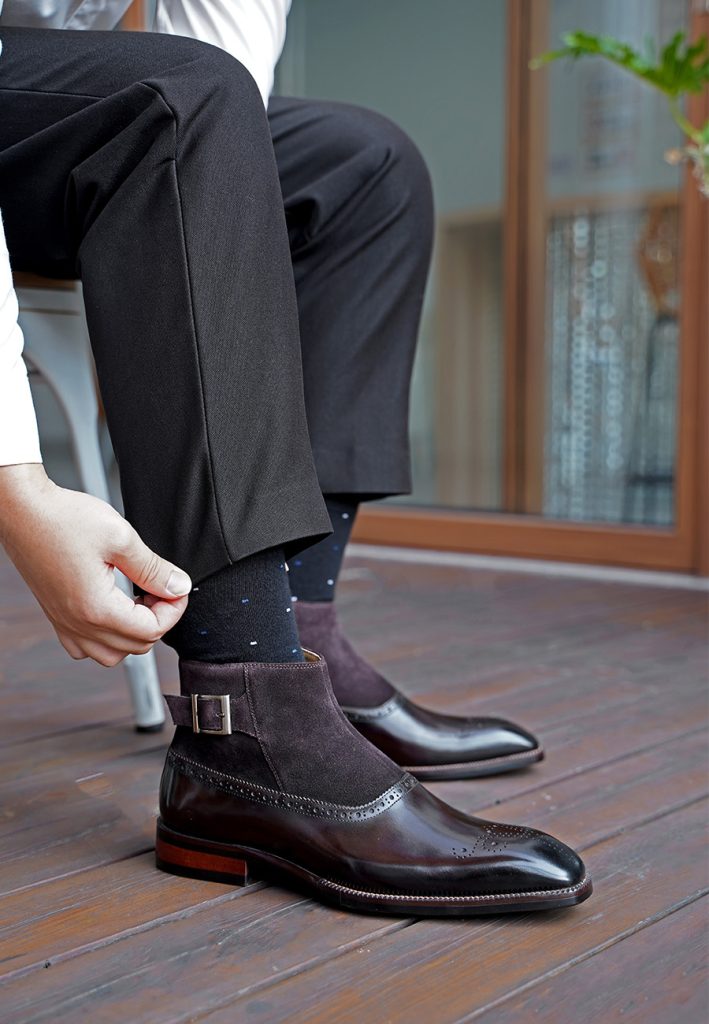
Top-grain leather is great for people who want a more polished and consistent appearance in their boots, with less concern about unique marks or patina.
Comparison Table: Full-Grain vs. Top-Grain Leather
| Feature | Full-Grain Leather | Top-Grain Leather |
| Surface | Natural, unaltered | Sanded, smooth |
| Durability | Maximum | Very good |
| Look Over Time | Develops patina | Holds a polished look |
| Price | Highest | Slightly lower |
| Best For | Long-lasting, premium boots | Stylish, easy-care boots |
C. Suede and Nubuck
Suede and nubuck are types of leather that focus on a soft, velvety feel. They both start from the inner layers of the hide, but are finished differently.
Suede
Suede is made from the underside of the hide. It is very soft and has a fuzzy texture, often used for casual or fashion boots. It is less resistant to water and stains, so it needs more care.
Nubuck
Nubuck is made by sanding the outside surface of the hide, making it a bit tougher than suede but still soft to the touch. Nubuck has a velvet-like finish and is often used for boots that need both style and durability.
Why might you choose suede or nubuck?
- They are ideal for men who want boots with a modern, relaxed style.
- These leathers add a touch of luxury and uniqueness, making them popular for fashion-forward designs.
Tips for Care:
Since both suede and nubuck can stain easily, it is best to keep them dry and clean them with a special brush.
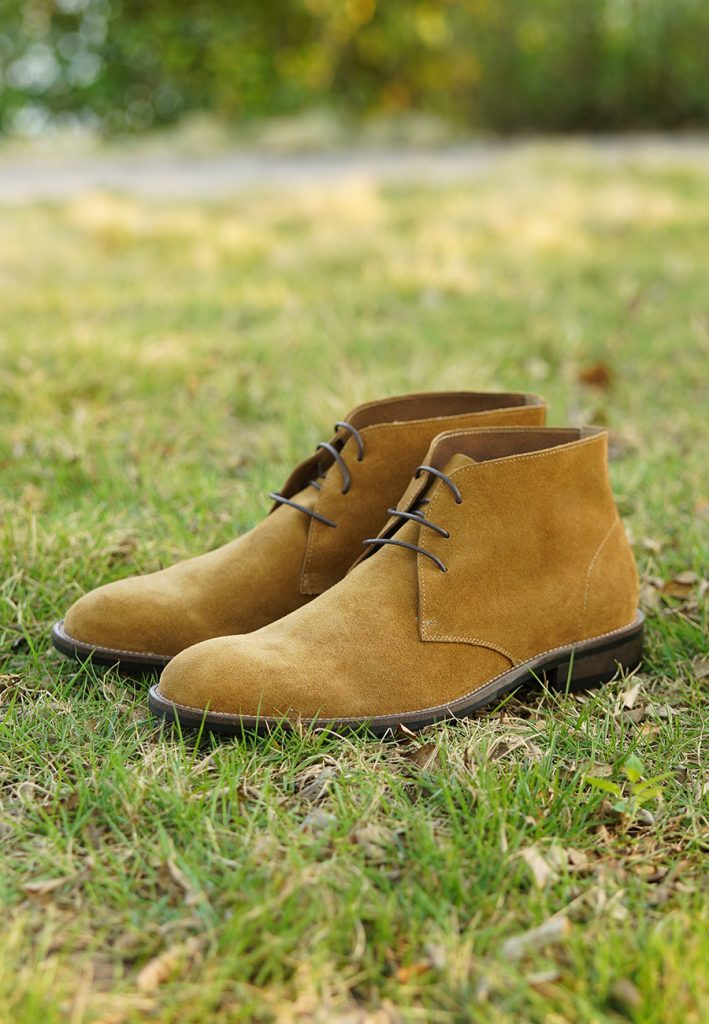
D. Specialty Leathers
Some men’s boots are made with specialty leathers, which include exotic hides or leathers that are specially treated for added features.
Exotic Leathers:
These come from animals like crocodiles, ostriches, or snakes. They have unique patterns and textures, making boots look very different and often more luxurious. These are usually chosen for high-end or statement boots, not for everyday use. They are more expensive and less common.
Treated Leathers:
Regular leather can be treated to improve its performance. For example:
- Waterproofed Leather: Keeps feet dry in wet weather.
- Waxed or Oiled Leather: Adds shine, makes it more resistant to water, and gives a rugged look.
- Oiled Leather: Feels softer and is easier to break in, which means the boots become comfortable more quickly.
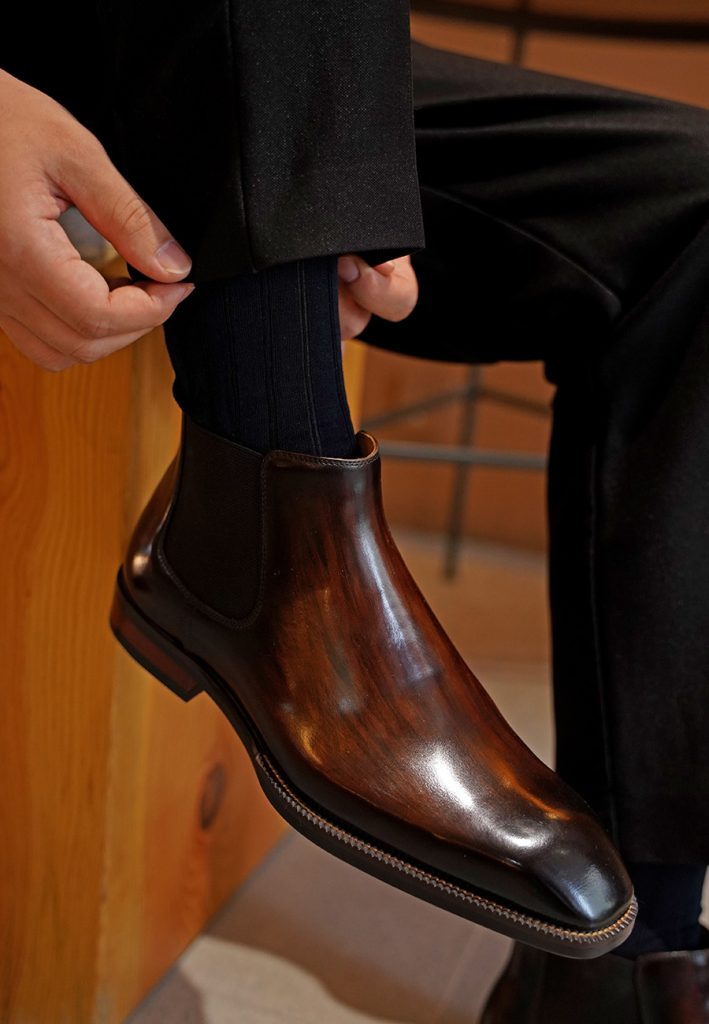
Fair Comparion of Types of Leather and Their Features
| Leather Type | Typical Use | Key Features | Best For |
| Full-Grain | Premium dress boots | Most durable, unique patina | Long-term, classic wear |
| Top-Grain | Stylish/formal boots | Smooth, easy to clean | Sharp, uniform look |
| Suede | Fashion boots | Soft, casual, trendy | Relaxed, modern style |
| Nubuck | Stylish, sturdy boots | Velvety, tough | Durable, stylish wear |
| Exotic Leathers | Luxury, statement | Unique patterns, eye-catching | High-end, special events |
| Treated Leathers | Outdoor, work boots | Protective, weather-resistant | Functional, rugged use |
III. Identifying Leather Quality in Boots
A. Look and Feel
When checking the quality of leather in men’s boots, start with your senses. High-quality leather often keeps some of the animal’s natural marks, such as tiny scars or textures.
These are not defects but signs the leather is real and less processed. You will also notice that premium leather has a deep and rich color.
The color may look slightly different when you move the boot under light. This shows that the dye has soaked in well and the leather is high grade.
In contrast, fake or low-quality leather may look plain, have a shiny or plastic-like coating, and feel stiff or slippery.
B. Structural Integrity
Structural integrity means how well the leather keeps its shape and strength over time.
Good leather will feel sturdy when you touch it, and if you press with your thumb, it should spring back instead of staying dented.
High-quality leather can flex and bend without cracking or forming deep creases. It also stretches just enough to fit your foot comfortably but does not become loose.
Another important point is breathability: real leather allows air to move through, which helps keep your feet cool and dry.
C. Longevity Factors
How long your boots last depends on the type and thickness of the leather. Thicker leather with tightly packed fibers stands up better to daily use, resists damage, and keeps its shape longer.
High-quality leathers age well and form a patina, which is a rich, attractive shine that develops with time and care.
This is a sign of premium leather and adds to the look of the boots. In contrast, cheap or thin leather often cracks, peels, or loses its color after a short period, especially if used often.
IV. Craftsmanship and Construction: Elevating Boot Quality Beyond Leather
Choosing the best leather is only one part of making great men’s boots. The way the boots are made, called craftsmanship and construction, matters just as much. Good construction makes boots last longer, feel comfortable, and look impressive.
Here is what you need to know:
A. Goodyear Welt Expertise
The Goodyear welt is known worldwide as the gold standard in bootmaking. This technique involves stitching the upper part of the boot, the sole, and a special strip of leather (the welt) all together.
This strong bond helps keep water out and makes the boots extra durable.
Why is Goodyear welt so important?
- Superior Durability: Boots made with this method can handle years of wear without falling apart. The stitching holds everything tightly in place.
- Water Resistance: The construction prevents water from getting in, so your feet stay dry even in wet weather.
- Easy to Resole: When the sole wears down, you can replace it without damaging the rest of the boot. This means one pair of boots can last many years.
B. Hand-Finishing Excellence
Hand-finishing is all about attention to detail. Skilled workers use their hands, not just machines, to add color and shine to each pair of boots. One key technique is patina hand-coloring, where layers of color are added by hand for a unique look.
Why does this matter?
- Unique Appearance: No two pairs look exactly the same. Each boot has its own character and style.
- Rich Color: Layering colors by hand gives boots a deep, vibrant look that machine finishing cannot match.
- Higher Perceived Value: Customers often see hand-finished boots as more special and are willing to pay more for them.
C. Hengxin’s Unmatched Manufacturing Advantage
At Hengxin Shoes, quality and efficiency are seamlessly integrated. We masterfully blend traditional craftsmanship with modern production, giving every pair a distinct handcrafted feel while reliably fulfilling orders of any scale.
A key expression of this expertise is our custom men dress shoes service. Whether you are launching a new line or expanding an established brand, we offer flexible solutions—from wholesale to fully custom collections—designed to bring your unique vision to life.
Our team collaborates closely with you to ensure that every detail, from the initial sketch of your custom men dress shoes to the final product, truly reflects your brand’s identity. With Hengxin, you gain a partner committed to uncompromising quality and reliable support, providing the craftsmanship and service you need to grow a distinguished brand.
V. Conclusion: Choosing the Right Partner in Leather Boot Manufacturing
Choosing the right partner for leather boot manufacturing is an important step for any brand.
When you understand different leather types and how to spot good quality, you build trust with your customers and keep them coming back.
Success comes from using the best leather and combining it with skilled craftsmanship.
At Hengxin Shoes, we bring together traditional artisanal methods and large-scale production.
This means you get beautiful, well-made boots ready for wholesale or private-label needs. By working with us, you can offer products that make your brand stand out for quality and style.
VI. FAQ
- What are the main types of leather used in boots?
The main types of leather used in boots are full-grain leather, top-grain leather, suede, nubuck, and sometimes specialty or exotic leathers like crocodile or ostrich. Full-grain leather is the highest quality and comes from the top layer of the hide. Top-grain leather is also from the upper hide but is sanded for a smoother finish. Suede and nubuck are both made from the inner layers of the hide and have a soft, velvety texture.
- How can you tell if boots are made from genuine full-grain leather?
To tell if boots are made from genuine full-grain leather, look for natural marks or slight imperfections on the surface. The leather should feel firm but flexible, and the color may have depth and some natural variation. Full-grain leather also develops a rich patina over time, which is a sign of authenticity.
- What is the difference between suede and nubuck in bootmaking?
The difference between suede and nubuck is in how the leather is finished. Suede is made from the underside of the hide and has a soft, fuzzy feel. Nubuck is made by sanding the outside of the hide, giving it a similar soft texture but making it a bit tougher and more durable than suede.
- Do different types of boot leather require different care methods?
Yes, different types of boot leather need different care methods. Full-grain and top-grain leathers usually need regular cleaning, conditioning, and sometimes waterproofing. Suede and nubuck require special brushes and sprays to keep them clean, and they need to be kept dry because they can stain easily.
- Why is patina finishing valuable in premium leather boots?
Patina finishing is valuable in premium leather boots because it gives the boots a unique character and rich color that improves with age. As the leather develops a patina, the boots look more distinguished and attractive, which adds to their value and appeal.

